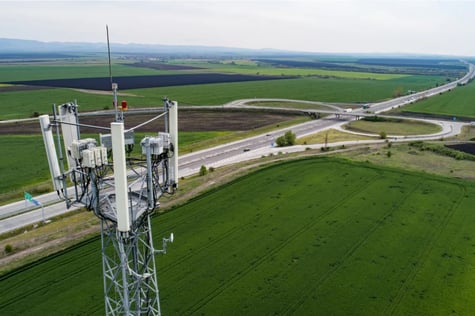LTE 450 is a type of wireless communication network which effectively meets the critical needs of many important operations. Electricity supply, other utilities, public safety services and logistics are just some of the sectors it can serve.
The wide reach and deep penetration of its signals enable effective connectivity over large areas and to difficult to access locations – which are poorly covered by mainstream networks. LTE 450 is economical as it has a large coverage arena, meaning it needs fewer base stations to cover a fixed area to deploy and use. It also provides a highly secure and reliable connection, and can be easily modified in line with current and future requirements.
Wide coverage
At low frequencies, like that of LTE 450, radio waves are longer and travel further, resulting in better signal propagation characteristics compared to higher-frequency networks. Blanket communication coverage can be spread across large expanses of countryside or sea. This makes LTE 450 ideal for connecting with dispersed populations, and with remote or rural areas through the use of smart grids.
Deeper signal penetration
The low-frequency radio waves of LTE 450 also penetrate deeply into buildings and below ground, passing easily through obstacles such as walls. This is particularly useful for connection with, for example, electricity or water meters located in basements.
Cost saving
A wider signal reach means there are fewer base stations, radio sites or towers to install, manage and maintain – saving on both initial investment and ongoing costs.
Thanks to deeper signal penetration, IoT devices and other equipment in hard-to-reach locations can easily communicate with the LTE 450 network. Without it, they would fail to connect and communicate.
Economies like these combine to make LTE 450 infrastructure less expensive to build compared to all other cellular networks. In fact, in some cases the LTE 450 legacy infrastructure which was used previously for a different purpose can be taken over for a new application.
For complex, widespread organisations and operations, LTE 450 can reduce expense by replacing multiple physical and wireless networks with a single, consolidated, simplified network. For example, LTE 450 can provide reliable meter readings without the cost of a physical network.
Security and reliability
Private LTE 450 connectivity has lower congestion and is free of interference when compared to that of high-frequency public networks. It is also inherently more secure against cyber threats and interference, and can be specified with extra inbuilt security features.
The lower cost and wider coverage of LTE 450 infrastructure means a more manageable number of base stations need to be active to maintain connection to critical devices in the situation of a power failure. This further enhances its reliability. Meanwhile, its lower complexity, with fewer stations, means there is less risk of failures and outages.
Control, flexibility and future proofing
Private LTE 450 gives utility companies more control over their network. Operators provide SIMs to companies that are able to make their own decisions on how it is managed, regardless of what a public network provider wants or is able to do. They can tailor everything to their specific connectivity and communication needs.
With LTE 450, it’s easy to upgrade, grow and modify the network as needs change. Importantly, LTE 450 complies with a global standard, aligned with 5G, which also helps to make it future-proof.
To learn more about LTE 450, download our free complete guide.




